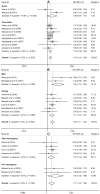Association between estrogen receptor α gene (ESR1) PvuII (C/T) and XbaI (A/G) polymorphisms and hip fracture risk: evidence from a meta-analysis
- PMID: 24482673
- PMCID: PMC3903335
- DOI: 10.1371/journal.pone.0082806
Association between estrogen receptor α gene (ESR1) PvuII (C/T) and XbaI (A/G) polymorphisms and hip fracture risk: evidence from a meta-analysis
Abstract
Background and objective: Genetic factors are important in the pathogenesis of fractures. Notably, estrogen receptor α (ESR1) has been suggested as a possible candidate gene for hip fractures; however, published studies of ESR1 gene polymorphisms have been hampered by small sample sizes and inconclusive or ambiguous results. The aim of this meta-analysis is to investigate the associations between two novel common ESR1 polymorphisms (intron 1 polymorphisms PvuII-rs2234693: C>T and XbaI-rs9340799: A>G) and hip fracture.
Methods: Crude odds ratios (ORs) with 95% confidence intervals (CIs) were used to evaluate the strength of the association.
Results: Five case-control and three cohort studies were assessed, including a total of 1,838 hip fracture cases and 14,972 healthy controls. This meta-analysis revealed that the PvuII T allele is a highly significant risk factor for hip fracture susceptibility, with an effect magnitude similar in male and pre-menopausal and post-menopausal female patients. In stratified analysis based on ethnicity, the PvuII T allele remained significantly correlated with increased risk of hip fracture in Caucasian populations; this correlation, however, was not found in Asian populations. Unlike the PvuII polymorphism, we did not find significant differences in the XbaI (A>G) polymorphism allele or genotype distributions of hip fracture patients and controls. We also found no obvious association between the XbaI polymorphism and hip fracture in any of the racial or gender subgroups.
Conclusion: Our findings show that the ESR1 PvuII T allele may increase the risk of hip fracture and that the XbaI polymorphism is not associated with hip fracture.
Conflict of interest statement
Figures





References
-
- Chudyk AM, Ashe MC, Gorman E, Al Tunaiji HO, Crossley KM (2012) Risk of hip fracture with hip or knee osteoarthritis: a systematic review. Clin Rheumatol 31: 749–757. - PubMed
-
- Sandhu A, Sanders S, Geraci SA (2012) Prognostic value of cardiac troponins in elderly patients with hip fracture-a systematic review. Osteoporos Int. - PubMed
-
- Martinez-Reig M, Ahmad L, Duque G (2012) The orthogeriatrics model of care: systematic review of predictors of institutionalization and mortality in post-hip fracture patients and evidence for interventions. J Am Med Dir Assoc 13: 770–777. - PubMed
Publication types
MeSH terms
Substances
LinkOut - more resources
Full Text Sources
Other Literature Sources
Medical
Miscellaneous

